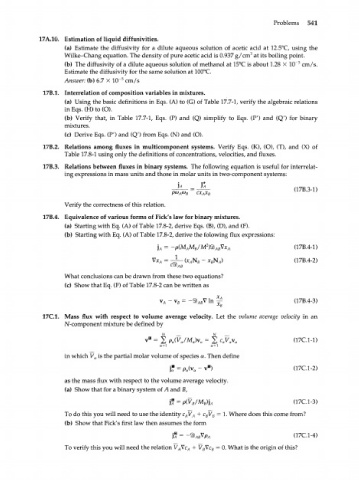Page 561 - Bird R.B. Transport phenomena
P. 561
Problems 541
17A.10. Estimation of liquid dif fusivities.
(a) Estimate the diffusivity for a dilute aqueous solution of acetic acid at 12.5°C, using the
3
Wilke-Chang equation. The density of pure acetic acid is 0.937 g/cm at its boiling point.
5
(b) The diffusivity of a dilute aqueous solution of methanol at 15°C is about 1.28 X 1СГ cm/s.
Estimate the diffusivity for the same solution at 100°C.
5
Answer: (b) 6.7 X 1(Г cm/s
17B.1. Interrelation of composition variables in mixtures.
(a) Using the basic definitions in Eqs. (A) to (G) of Table 17.7-1, verify the algebraic relations
in Eqs. (H) to (O).
(b) Verify that, in Table 17.7-1, Eqs. (P) and (Q) simplify to Eqs. (P') and (Q') for binary
mixtures.
;
(c) Derive Eqs. (P ) and (Q') from Eqs. (N) and (O).
17B.2. Relations among fluxes in multicomponent systems. Verify Eqs. (К), (О), (Т), and (X) of
Table 17.8-1 using only the definitions of concentrations, velocities, and fluxes.
17B.3. Relations between fluxes in binary systems. The following equation is useful for interrelat-
ing expressions in mass units and those in molar units in two-component systems:
U J*
=
Verify the correctness of this relation.
17B.4. Equivalence of various forms of Fick's law for binary mixtures.
(a) Starting with Eq. (A) of Table 17.8-2, derive Eqs. (B), (D), and (F).
(b) Starting with Eq. (A) of Table 17.8-2, derive the folowing flux expressions:
2
U = -p(M M /M )® Vx A (17B.4-1)
B
A
AB
± (x N - x N ) (17B.4-2)
A B B A
CJ) AB
What conclusions can be drawn from these two equations?
(c) Show that Eq. (F) of Table 17.8-2 can be written as
v A - v = -2) У In g (17B.4-3)
B
Л6
17C.1. Mass flux with respect to volume average velocity. Let the volume average velocity in an
N-component mixture be defined by
v a = 2 P (Va/M )v = J c V v (17C.1-1)
a a a a a a
in which V is the partial molar volume of species a. Then define
a
H
j " = Pa(v -v ) (17C1-2)
a
as the mass flux with respect to the volume average velocity.
(a) Show that for a binary system of A and B,
jj = p(V /M )] A (17C.1-3)
B
B
To do this you will need to use the identity c V + c V = 1. Where does this come from?
B
B
A
A
(b) Show that Fick's first law then assumes the form
)A =
To verify this you will need the relation V Vc + V Vc = 0. What is the origin of this?
A
A
B
B

